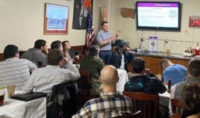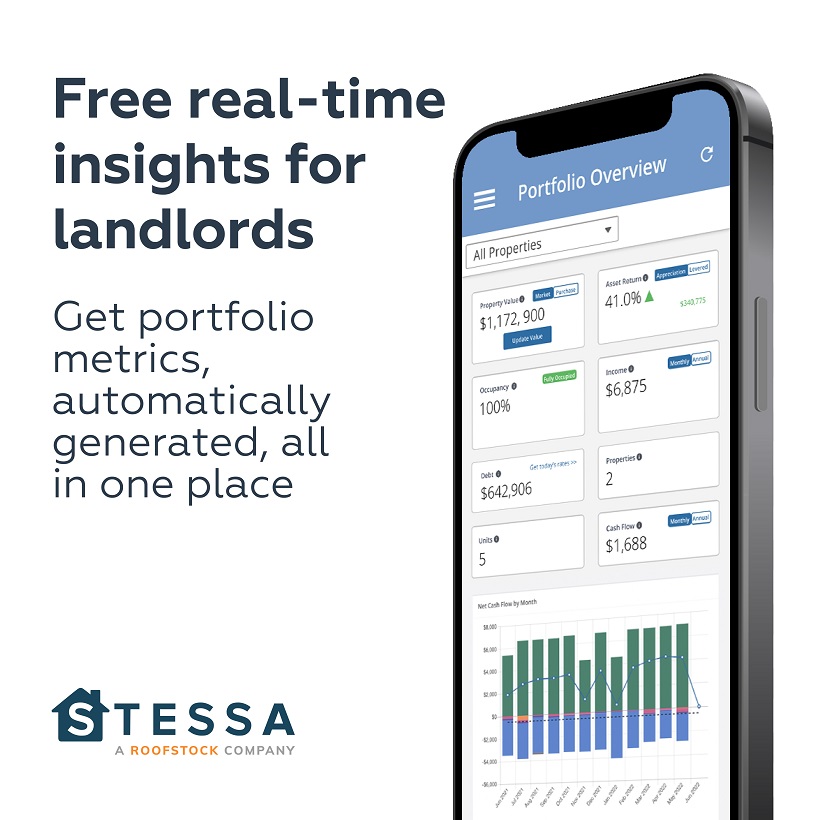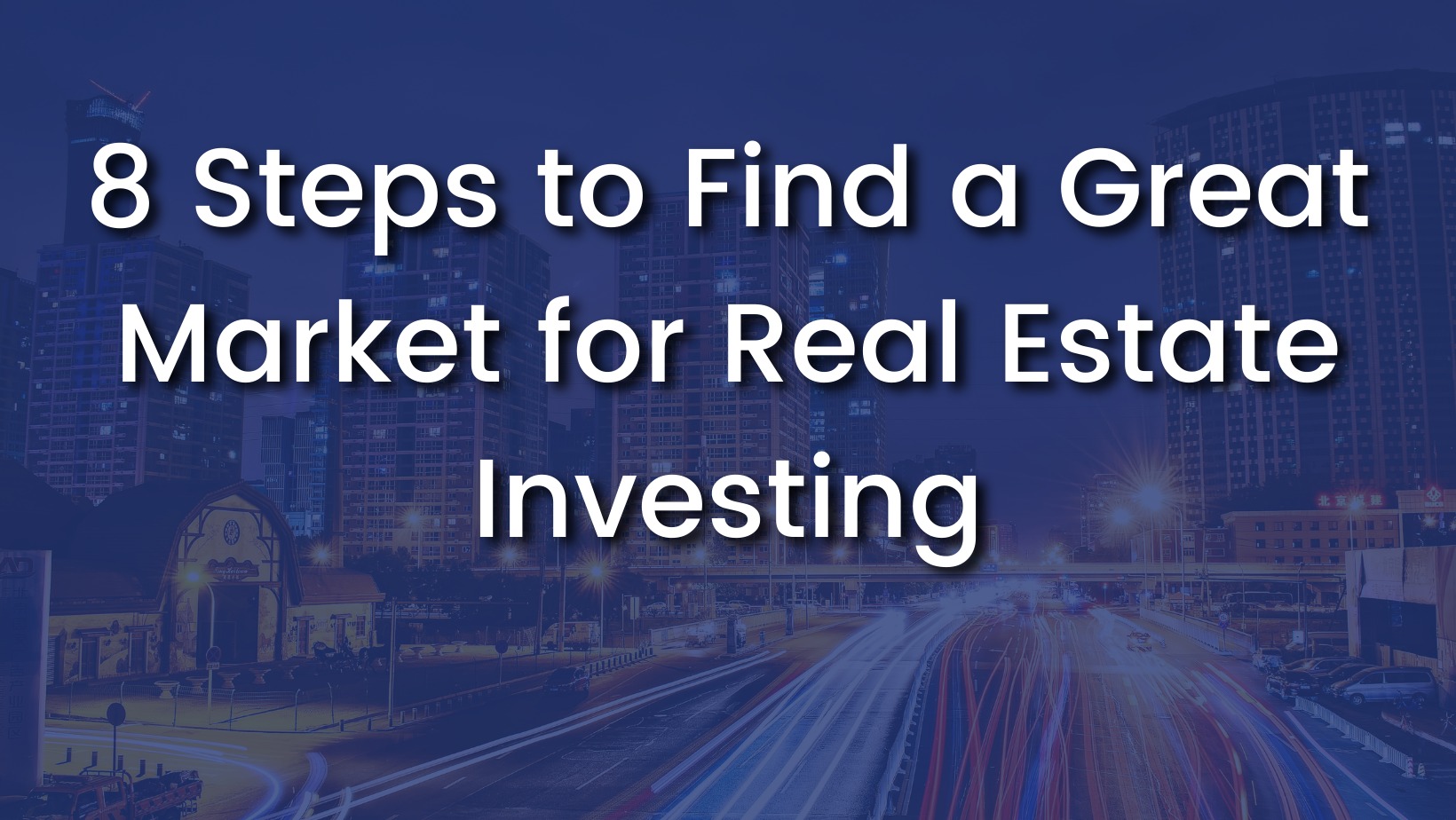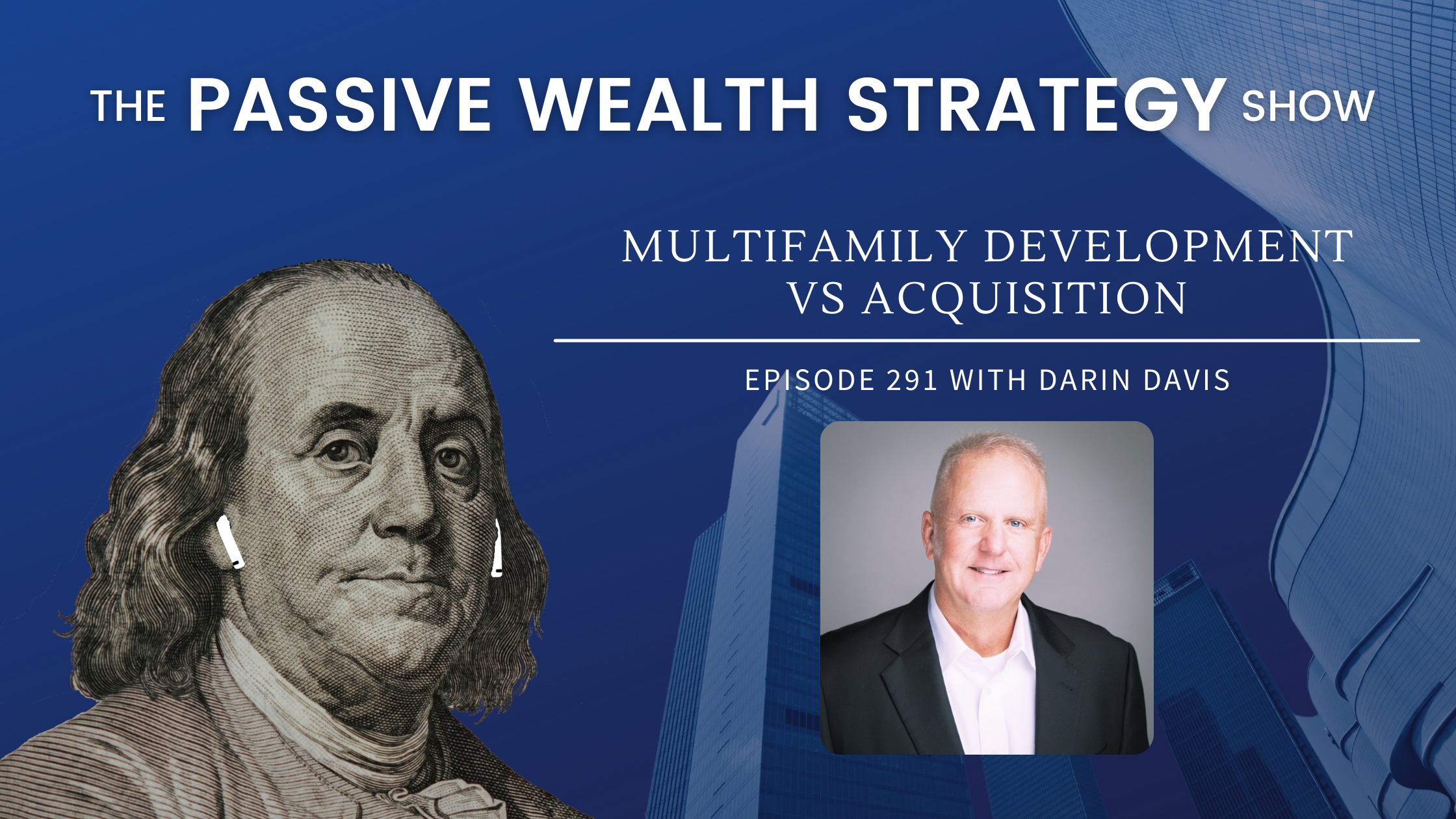
Multifamily Development vs Acquisition with Darin Davis
Darin, thank you for joining us today.
Thanks for having me. I’m looking forward to the conversation.
It’s been a great conversation so far, and you have a wealth of experience that I’m really excited to continue learning from you. And, I already have been, have had the fortunate situation too, and for our listeners out there who don’t know about you and your business, can you give us a quick intro?
And then we’re going to dive into multifamily development.
Yeah. My business partner, Tom Burton, and I started this company really informally in 2008, 2009. And we knew at the time that we were both committed to real estate and passive income and ended up just growing a business, but it wasn’t until probably, and we’d invested together, but it was probably about four and a half to five years ago.
I think both of us looked at each other and just said, you know what? We love what we do. We understand real estate. We’d been in it 15, 20 years. We had the same goals. We have a very common bond and everything we believe in. And we said, let’s start the company. And we literally started our first hire.
We’ve got a team of seven now. We primarily do develop. But we do acquisition and there are some reasons for that. And we’ll probably talk about that a little bit later, but we’re based here in Austin, Texas, for which we’re very fortunate. I can’t say we’re the smartest guys. We just have to be in Texas and then being in central Texas and then being in Austin, gives us a lot of advantages.
Don’t see any reason for us to do a lot outside of the state of Texas. We just continue to grow a business-friendly environment here. We just feel that we’re very.
Yeah, absolutely. Our Texas and Austin, in particular, have had some very let’s say fortunate market dynamics, but there are reasons for that business-friendly.
Like you said, a lot of very good reasons behind that. And today in the multi-family investing space, I feel like we hear mostly about folks doing acquisition and value. Add, sell it in three to five years where the timeline is different, but that’s the model where. I think there’s probably a lot of opportunity in doing the development of multi-families.
So I’d like to discuss with you why invest in multi-family development and what are your thoughts about mixing that into a more, broader investing straps? Sure.
Sure. We started out just straight-up acquisition. We’re not developers, we’re not general contractors. We’re nothing like that.
But as we looked at our space most recently, we said, what are we good at? And we said, okay, we have a lot of lands here. And Tom and I’ll kinda go back to 2008, 2009. We had, we learned a lot back then. If the guys are old enough to remember what was going on in real estate back then, but we had actually bought a piece of.
And I remember having a term sheet from a lender to go forward with the financing. I get a call one day and said, we’re withdrawing our term sheet in our offer. I said we can’t, we’re going forward. And it was Sumi, whatever. So every, it just all went away.
So we had to put stuff together and figure it out. The fire hose. Straight, honest, in the mouth. And we were like, how do we pull this off? It took us a little bit, but we learned that the only way we were going to pull this project, then we had investors in it already.
We had done some land acquisition. We had done some engineering, some architects. But we had to learn a new debt structure, and we had to hire a GC and we had hired a developer. And at the time, it was a lot of lessons learned. Did we do everything perfectly? No still to this day, 11 years later, we have that asset still, and it’s been one of our best-performing assets, that we’ve had from a cash flow perspective.
So we’re very proud of that, but you fast forward to today. If you look at the competition, especially here in Austin, you can have one property being bid on by 20 different groups, qualified groups. There’s a lot of capital out there. We’re seeing, three, three and a half cap rates.
And in my opinion, We’re losing control of that. We’re losing control of the forest before the trees, the side of, what are we doing here? We’re just all nuts, and we sit back and I’m going, like, where do we have the most control? If we go acquire the land, And then we start the development process we’re competing with just ourselves.
We have the ability to find out if we don’t go buy raw land with no utilities or no discounting, there are utilities, there’s zoning, we know what we’re getting, but we have so much more control. And that’s not to say that we’ve abandoned the acquisition cash flow model, but we looked at this and said, you know what?
It doesn’t hurt to do it. You might not get cash flow in the first two to three years, but if I can two X your investment as an investor by here three and a half or four, you’re probably not going to call me up and complain. You can probably take that cash and find another cash flow or find another development.
Just diversify a little bit. It was good for us. It was good for our investors.
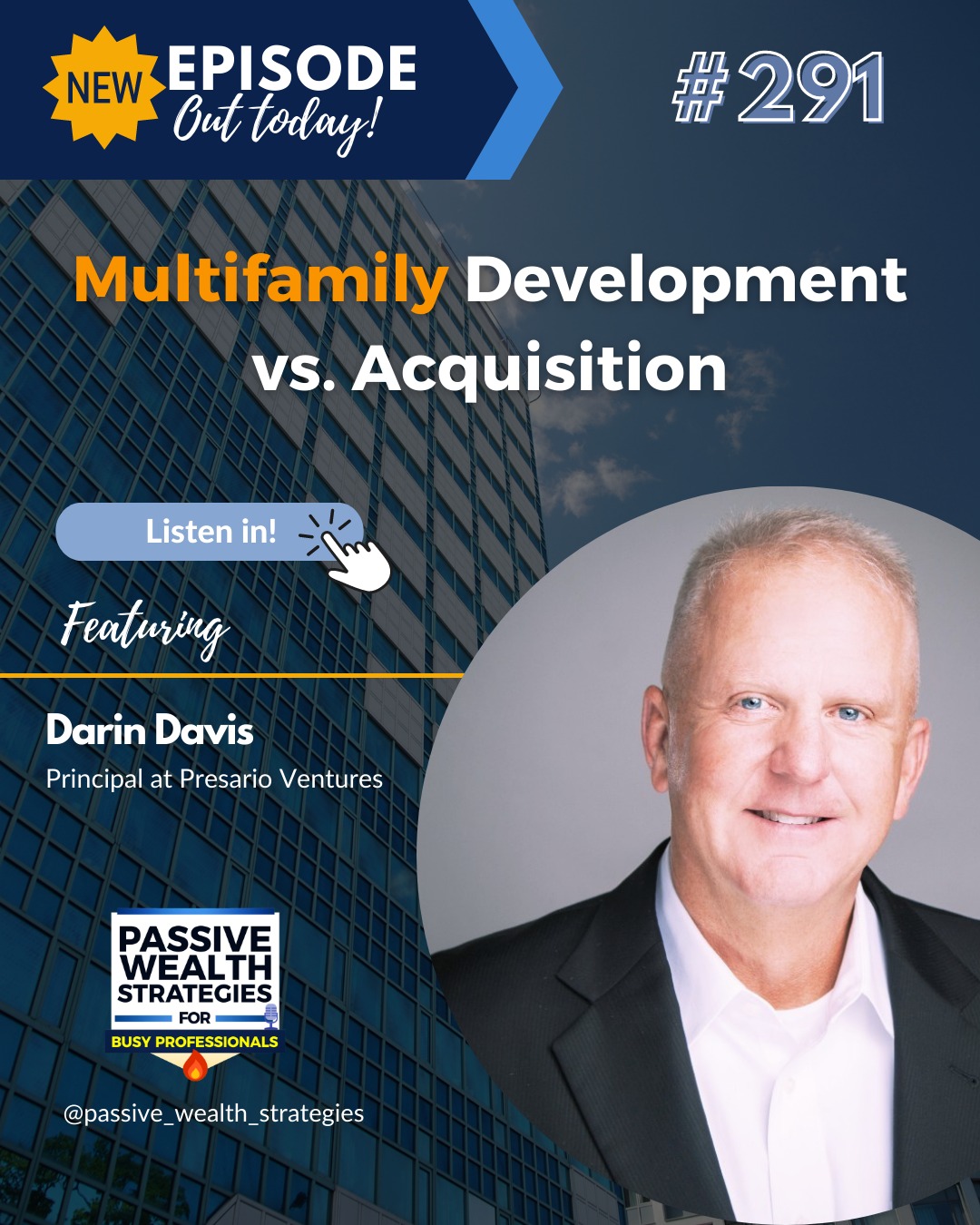
Multifamily Development vs Acquisition with Darin Davis
Nice. I definitely can appreciate why folks might want to go for that upside. And I can see that you’re in a way you’re stepping back from some of the madness of the acquisition market, where folks are competing at a three, three and a half cap for existing assets, and you’re developing them right as, so your 2008, 2009 properties, you said you still have.
Now is that the model that you’re still pursuing, the properties that you’re working on and putting together today you’re planning on holding those for 10 years, or what’s the strategy moving forward? Is it build it, sell it off. Yeah, what are you doing?
That’s a great question. And yes.
Okay. So when we put these together, the way we do our agreements, you typically have your general contractor and developer that are ready to exit their merchant builders. They want to build it, sell it, and move on. We’re private. So we want to come in and we want more options in that, that we’re not going to if we’re going to, double, triple our money in three or four years.
And it makes sense to do that. We actually have, I’ll back up. We have an asset right now that we went to, that we are getting offers on that we wanted to compare. What our performance looked like that they gave our investors two and a half years ago. And it’s not even on the proforma because we’re making that much more money than what the proformas showed at, you’re 7, 8, 9.
But with that said, we do a first right of refusal with the developers. We have a buy-sell, if they want to sell, we get. We have if we can do the refi model, we love that model. In fact, the asset we were talking about here in Austin from 2009 we’ve refined that twice.
So we’ve been able to pull cash out and give it to our investors. That money comes out tax-free on the front end. And people love that. And that is if we could pick a model and stick with it, it would be to build. Then stabilize then refi and they cashflow and then refi cashflow. You just keep on going, but it never worked out like that all the time, but that’s really our model.
We liked that model but we’re not merchant builders. We would like to hold it if we could, but it doesn’t always work out that way.
So the thing that really comes to mind for me here, there’s a lot of things that come to mind, but. The first thing I think about are the actual costs of development as compared to the costs of buying existing assets.
Do you buy existing assets? You’re going to have a lot of, probably a lot of rehabs to do is you have to bake that in. Whereas these days we’re hearing so much about, it’s hard to find a labor. It’s hard to find different, hardware and wood was going crazy there for a little while. How does that all shake out when you’re looking at.
The cost of development and especially compared to. At theoretical market downturn, you don’t want to have a, I’m just putting a number out there at $200,000 per unit cost to develop. And then you get a few years down the road and they’re only selling for one 50 a unit or something like that.
How do you shake it out against the existing assets in terms of costs?
That’s a very good question. So there’s no doubt about it today. We’re going to do some charter waters, we’re seeing lumber up four X. Now it’s come down half that we’re seeing supply chain, mishaps, Appliances in certain places there are all kinds of things at me.
And we’ve been managing through that it as added some time to our development. But with that time, we’ve also learned quite a few lessons about with it’s forced us to find new vendors. It’s forced us to find new general contractors. It’s forced us to do things that we hadn’t done in the past and things are normalizing more today.
Now is that going to last, or do we have another pandemic issue? And we have another pause in the market, we don’t know. We’ve got 10 years’ experience. We have a great partnership group and far as GCs and developers, we know who’s got the buying power who can deliver it is a little bit of a risk but at something that we’ve been able to manage through today and along with that, Inflation’s kind of the big buzzword now, what’s happening.
If you look at real estate, it, if it parallels, if the inflation of the services on the backside, on the cost side are going up typically inflation on the top. The rents are matching us. Okay. So they seem to work together for the most part. So we don’t get big swings and expenses where inflation or the top line is not addressed also.
So for us, if you, and if you think about this, when you get that long-term. And you’ve got fixed debt at, three, three and a half, 4%. Yeah. And that, but your inflation continues to go 3, 4, 5, 6, 7. That’s spread on your debt. The coverage ratio gets so big that you have the ability to take on a large correction.
And you start looking at debt coverage, the ratio of fixed at one when you start the. Meaning 110%, but then your rents continue to grow. That gap gets bigger and bigger. So there’s a lot of redundant. We do sensitivity underwriting. So we’ll say, okay, where is our break?
Even and a lot of times we’d have to be in the seventies. Two to 75% occupied and had our rents would have to be 30, 35% less than what they’re currently trending for right now. So we put a lot of space in between the good and the probable or possible. So it’s worked out so far and there’s a lot of math behind it.
You’re an engineer, you understand that? You can say, Hey, these guys have got enough cushion built in there. They’re probably going to be.
Yeah. I’m glad you, we talked about inflation and how that impacts or how debt is really a tool to somewhat amplify our return.
But if we’re paying 3% on long-term money and inflation is running it three and a half or 4% or even more, that’s almost free money from lenders.
Three-and-a-half or four or five a year and times three or four years. And all of a sudden you’ve got that fixed debt, and we also some of your guys, your audience may or may not know about this, but there are some products out there that are uninsured and that debt gets to 35 and 40 years am and 35 and a 40-year term.
So you start fixing 3.1, 3.2. There have even been some sub-threes for 40-year debt. You take out that interest rate. You’ve got an asset there. That’s been dead, becomes your friend. The big time you get the right debt on an asset. You can manage the rest of it.
Absolutely. Now, when I think about development more broadly and also, what I see around me and I’d invite the listeners to think about any developments that you see around you in your town. We pretty much just see. What most people would describe as a class, a high-end new development, or pretty close to the high-end stuff.
That’s going to command top-of-market brands. It’s not going to be, what you might call affordable housing or something like that. Is that what in Austin? And if so, why is that? Let’s talk a little bit about, how you target that, that strata of the market that your product is going to.
That’s probably a very relevant question because we’re very unique in that aspect. You are not going to see us go downtown, do attend 10 story, mid-rise in downtown Austin. That’s not us. We are absolutely the secondary market. We liked that garden-style product drive up garden style, bread, and butter, just really, let’s just lather, rinse, repeat, and let’s keep going.
So we go into the suburbs that have, they have major thoroughfares, major highways that get, for the transportation school district. We go into the, anything in our, like our Austin MSA, would really be about a 30-minute radius around us. If you go south of Boston, now you’re getting into San Antonio or San Antonio.
So we have this between north Austin and south San Antonio. We’ve got about 120 miles on , which is our major corridor and the state of Texas. There’s a lot of lands. And there’s a lot of infrastructure being built and the people just keep coming. We have, we, the state of Texas have a 200,000 unit plus deficit of housing right now.
And we can’t, and it keeps growing every year. We can’t keep up with it. If you look at the jobs and the employment that just keeps moving. For the cost of living job-friendly state Texas is going to be fortunate. For the most part of the United States needs housing, but Texas is just unique and it needs more housing.
And we’re going to, we’re going to fill that gap in the secondary market. We like that. The other thing that we’ve really started looking into and we’re doing our first one. It’s a product called bill to rent. I don’t know if you’re aware of it, but it’s like a subdivision of single family homes.
That’s like a multifamily plat. So you still have a clubhouse. You still have property management. You still have everything. But everybody has a little 1100, 1200 foot garden-style home with a one-car garage, typically a backyard. And they get a home, a small home, but they don’t have all of the maintenance and upkeep of a single-family home.
And they don’t have to come up with a 20, 25% to buy that single-family home type product. And we saw those become real popular at the beginning of the pandemic because people want to space, they didn’t want to be on top of each other. They have this product in Phoenix, Orlando, and it’s done incredibly well.
I think you’re going to see a lot more called BTR build to rent. We’re doing our first one in Houston right now, and we’ve got another one lined up probably to start by Q1 of next year’s high demand for those right now.
Interesting. So it is that is something that I’ve heard of, but I feel like I’ve only heard of the What’s the best way to put this, the big money wall street guys headphone hedge funds with enormous amounts of capital that they need to deploy going for that.
And I don’t know, you don’t strike me as one of those guys, and I’m not that you’re not a big-money guy, you’re not calling it from wall street. You’re calling it from.
We’re boots on the ground. We have relationships, we have friends, we know the developers. We know the landowners around here.
And a lot of guys would like to do this is what the guys they know, and we’re not going to ever compete with, a billion-dollar fund for build a rep product. But we can sure. Knock out two a year for the next 10 years, that’s something we can do all day every day.
But I do wonder about those, how the.
I go back to costs of construction, how that a build to rent more like a house, maybe like a townhouse. I don’t know exactly how your construction is, but how that cost would compare to a, probably more basic like the apartment-style type of thing as less like a home. Is it a marginal cost difference?
It seems like that would also take more land, but you said you have a lot of land. Yeah. W, what do you think about that? You got it all.
You’re exactly spot on and all of it, but here’s the kicker. Okay. Now you did good. You did really well, but here’s the kicker. It’s such high demand for that product right now that rent premiums are about 30 to 35% higher for the same amount of square footage.
In a two-bedroom versus a build to rent two bedrooms. But you’re right. You have, you don’t have a common wall. Okay. So there are costs there. You have separated roof lines. There’s costs there, you have a more concrete drive, a little more driveway. So there are additional costs, but the rent premiums are.
Very nice. People want that product. You’ve got retirees that are saying, Hey, it’s time to downsize. I’m going to sell my home and take my million dollars, out of my home. And I’m going to go into a community where everything’s taken care of. And then you have, younger millennials that are coming in.
I said, I, I’m not ready to buy a home. I want to be more mobile. I don’t want to put down a hundred grand or a hundred, 200 grand for a home today and there, but then what that community some of these are incredible, the streetscapes, they may, they look like little, you guys aren’t old enough to know this, but they looked like a little Mayberry RFD, take a look like little small towns.
They’re really cool looking. And they’re really family-friendly. So they’re becoming very popular. And I think you’re going to see quite a bit more of that product. And I know that we’re looking for it because we have equity looking for it.
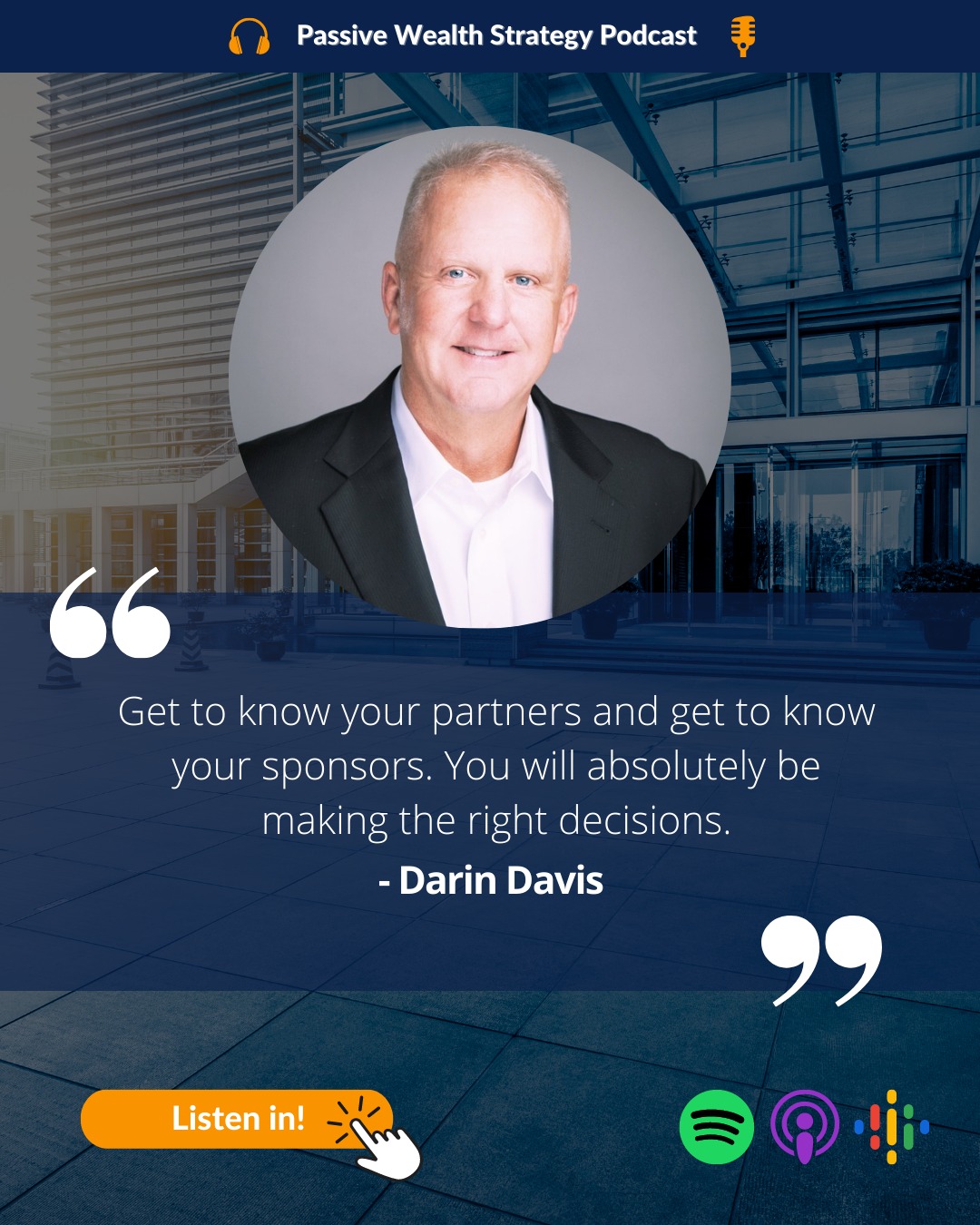
Get to know your partners and get to know your sponsors. You will absolutely be making the right decisions.
- Darin Davis Tweet
Nice. So I really want to make sure we get where the rubber hits the road, especially for the passive investors who are tuning in.
And, maybe they’re familiar with evaluating an acquisition of an existing property, but I’d like to ask your thoughts about it. What passive investors should look for? If they’re evaluating a development deal, like the ones you do. That’s like a grad-level underwriting course we’re going for the high points here, but what do you recommend folks look at in terms of priorities evaluating these deals?
Yeah, that’s a great question. And I got to tell you it’s not the brick and mortar. Okay. It’s absolutely the sponsor. You absolutely have to look at the sponsors tracking. You’ve got to ask them for references. You’ve got to know who the GC is for the group. And you’ve got to know who the development team.
All right. And if your sponsor can’t freely offer that information to you with their track record and they’re performing. That is probably not the right relationship for you. Tom and I have been doing this, realistically 20 years. And we’re very proud to say that we’ve got everything I just said, or I would’ve offered it up.
Of course, we have that and we have a track record. And we have repeat, we’ve got guys who’ve been with us for 15 years. Repeat investors. In almost every deal. It’s we know we can pick up the phone and say, Hey, we have one it’s a lot of times don’t make me look at the paperwork any more than you say, Hey, is it, do you like it?
Yeah, we’d like it. Okay. But that’s taken a long time to build up that relationship. But when you’re going to look at a develop. Everybody’s got pretty pictures and anybody, virtually anybody can develop it on paper. You’ve got to actually meet the sponsors, understand what they’ve done in the past, understand the exit strategies.
Okay. You’ve got to be very clear because if you have one way, you want to go with your capital and they are clearly telling you we’re going another way. There are sponsors that can, that you’ll be able to align with, and if you want something long-term, there are some sponsors that say, absolutely, we’re, long-term really offensive if and or buts about it.
Interesting.
One of the things that I want to make sure I ask about is like skin in the game for the sponsor. As when I passively invest in a deal, I want to know. The sponsor has them, they’re putting their own money on the line too. And I’m not the Rube who’s bankrolling the whole thing.
How does that all work? And especially with the contractors too, right? Because if folks out there flip the house or whatever, they probably had their own contractor issues. This is just a bigger scale. I imagine a contractor problem could be even worse. I don’t know.
Let me add the answer to the back part first.
So when we bring on developers and contracts, this is the same thing we do. How guys, how much money are you guys willing to contribute to the deal? I can’t say it happens every single time, but the majority of the time the developers and the GC contribute some form of their fee and or cash.
Okay. So that’s, we asked them to do that all the time. The other part of the. To be completely transparent with you in the beginning when Tom and I started this business, we put money in every time. Okay. So we were putting money into every single one of them. The volume became so much that we couldn’t fund every single deal the way it kept going, but we had earned our stripes, we said, okay, we understand the first year.
Second third, fourth, fifth, sixth. As we kept going, because we were building and holding these for cashflow it got to a point where we weren’t putting in as much money or in some cases, no money of our own, but I will tell you this, the amount of skin we have in the game is huge. The amount of time.
Energy. We have a staff of seven. We were funding this company to make sure that we cover all our bases 24 7, and every time that we make a decision. And every time it’s based off the equity, meaning the clients, our investors are based on the first, Tom and I will walk away from money to make sure our investors are made whole.
And we’ve done that before and we’d do it again.
That’s good. That’s good to hear. Speaking of Tom, he wrote a book. I want to make sure that we gave an opportunity to at least briefly discuss some of that. If you want to tell us about it the quick, I know you have a copy.
Oh, by the way, I just happen to have copyright here.
Now. That’s why doctors don’t get rich. It’s funny when I read this book, I knew about 80% of the stories, so I was going, oh, I remember that. I remember that. So yeah. Now Tom is a true educator and teacher that’s his passion and he does such a fantastic job at it. And I’ve seen him change the lives of several people just by spending one hour, two hours, three hours with them and just trying to shift their mind collect.
We all had with the rich dad, poor dad. There are so many of us who had that epiphany with that book. And I guess a little bit tell the story about how Tom and I met and I’m 99% sure. It was 99, maybe 1998. We met at a real estate conference and I’m sure it was the first conference that Robert Kiyosaki did.
And Tom was in Austin. I was in San Francisco at the time. And I heard an ad. I can interview on a Sunday afternoon radio show and it literally made me pull over my car and focus on it. I’d never heard something so simple and so common sense, go to the conference, and sure enough, knowing that I would be relocating back to Texas at the time I was engaged and we were both from Texas and we were going to move back.
We went over and talked to Tom and said, Hey, we’re moving to Austin. He was gracious that, Hey, here’s my number. Call me he’s an orthopedic surgeon, a very busy guy. And boy, he answered the phone and within, I think two hours, we knew we were going to be friends. We were like-minded and both just passionate about what we wanted to do.
We hadn’t gotten there yet. We didn’t know how we were going to do that. And we actually didn’t really become business partners for I want to say it was 2005 or six before we actually did a deal together, but we kept seeing each other around town kind of investing in the same type of stuff. And sure enough, we decided to formalize it and here we are in 2021 and we feel like we’re just getting stuck.
Nice. I love that. And I think that also speaks to the power of taking your time to get into a new business partnership. We see a lot of folks start partnerships so quickly these days, it feels like complainant about the kids these days. It makes you feel like an old man, but we see that happen a lot.
You guys took your time and that obviously worked out.
Yeah. It’s we’re still very much relationship-driven even with our investors. I still am, and I probably shouldn’t say this, but I’ve still floored that peak there are those crowdfunding sites that can raise as much money that they’ve never met the sponsors ever, and I’m just going to me, it’s wow.
I see good for them though, if they can do it’s but it’s I still like a handshake and an eyeball every now and then.
Absolutely. It’s funny. You should mention that I’m on, I’m subscribed to a few of those I’ll I’ve never invested in one. Email about a deal in my inbox today about acquisition somebody is doing where the I’m not going to say specific numbers, but let’s say the market there, the return that they projected was probably 6% above what is really possible in acquiring an asset, like a class, a asset, these days in a major MSA.
And, I dunno folks, maybe just look at the number and they see, oh, like such and such IRR. I’m going to go for it. That’s ridiculous. I doubt very highly. They’re going to be able to achieve that return, but they can send out an email blast saying that’s what they’re going to do.
Yeah. Yeah. I tell you what some of those, and I’ll give you you didn’t ask a question about it, give my opinion on something.
When you’re talking about passive investors, I’ve always thought of this. So many people are fixated on the IRR and you see these 18, 19 21, 23 IRR as well. I can give you a 50 IRR if you’d let me have your money for six weeks, I can get that IRR up there, pretty high, but I’m going.
Do you really want to risk putting in a hundred or a million, a hundred thousand or a million dollars if you’re only getting a small return because I can get the IRR really high, return it back to you quickly? I always tell younger investors that are starting really, really focus on either the multiple or the cash on cash.
That is because when you look at your cash on cash, Whether it’s 6% or 9%, you will understand that as a nonfinancial person, you put in a hundred grand, it’s a 10% cash on cash. You get 10,000 a year at once. You’re going to average. I always like to tell our guys, look at the multiple buy you’re putting in a hundred grand.
If the projection is a 1.8 multiple and you’re fine. Then, your money’s probably tied up for five years and you’re probably going to make 80,000 on your hundreds. So you’ll get a return of 180,000. You talked about kind of risk, if I know that I’m getting a good multiple, and I’m getting money back on my money, that’s something I liked for early investors, younger investors that are just getting started really focusing on.
I certainly appreciate that. IRR is very, I dunno, esoteric. It’s a weird metric and the ones you’ve mentioned make a lot more sense. Like you said, to a kind of nonfinancial person that can do the math in their head.
Sometimes they get so, wow. 28 IRR. How much money are you going to actually get back?
Yeah. For your a hundred thousand dollars.
Good luck. Figuring that out in your head.
That’s nice. Right now, we’re going to take a quick break for our sponsor. All right, Darren, I’ve got three questions. I ask every guest on the shell. Are you ready? I think I’m ready. I’m sure you are. First one. What is the best investment you ever made other than in your education?
That the best investment I ever made, other than education, I got three of them here and I was thinking, which one would I want to focus on?
It really is to be actionable and I say the best investment. The thing, we all know who Yogi bear is for the, the New York Yankees. I think one thing he said that really stuck with me at all the things he said was if you see a fork in the road, take it, just take it, quit the analysis paralysis in and ink.
It’s not going to be perfect the first time. It’s not going to be perfect. The second time I’ve been doing this 20 years, it’s still not perfect, but I learned something every single time, and I think, if I go to the. Outside of just a life lesson probably the best investment I ever made was in our team.
We, you talk about relationships. We have a team right now of seven people and I’ve got a business partner of 20 years for the most part that we took a lot of time to get to know each other and it’s important. And you mentioned it earlier, people getting a business partner too fast without fully vetting them.
I can’t tell you how important that is. You get one bad apple, as far as a partnership or an employee or a, a team member, it can be pretty devastating.
Nice. Can certainly appreciate that. We had the best investment. Now we go to the other side of that coin, the worst investment. What is the worst investment you ever have?
And I’m going to give you two answers again, kinda because it comes out to probably one of the things that are not listening to, the people that are closest to me, I’m a very trusting individual. And I think some of the worst decisions I made were I kept trusting the same person over and over again.
Go give him another chance. Give him another chance at some point. It’s okay to say. Just it, cut it off, move on. Okay. It’s just fine. Absolutely fine to say. Now, the other thing I would tell you when you talk about the investment itself I used to invest in stuff I didn’t know anything about, and I can’t tell you how many Texas oil and gas Wells.
I lost money in. Okay. So you know, oil and gas is a pretty big dummy. And you can make a lot of money, but you can lose a lot of money too. I never invested my friend’s money or my parents’ money or anything like that. It was mine. But I didn’t do a good enough job understanding the investment or vetting the investment.
And it’s okay to do it once. Okay. It’s maybe okay to do it twice, but when you’ve done it multiple times, it’s not. Yeah, I didn’t learn a lesson. It’s not. Okay. So that, those were some hard lessons, but I don’t do it anymore. Just FYI. Send me 20 years.
I don’t do it. Fair enough. Fool me once.
Fool me twice. Pull me three to pull me four times, five times, man. Come on. Now we gotta learn that.
Don’t let the tax tail like the dog.
That’s true. That’s true. I like that. I like that. My favorite question here at the end of the show is what is the most important lesson you’ve learned in business and investing?
I can’t be more serious about this is that I’m going to go with two answers again. Building a relationship. And you go back to what you said. It took my time getting to know Tom Thompson was time getting to know me. And here we are, five years of getting to know each other and a 15-year partnership.
It’s been. Yeah, I can’t say enough, get to know your partners, get to know your sponsors. You absolutely will make the right decisions. In fact the other night I had a woman asked me have you ever made any mistakes in investing? And I said no, Just to see what she would do.
And she goes, what are you perfect or something? I said, no, I’m not perfect. But I said, if I treated as a mistake and not a lesson, I go, then it is, then I did make a mistake. I said, but I am purposely trying to teach, to take every mistake and say, tell myself whatever. What did I learn from that thing, but as far as the other investment yeah I think if we look at it, from a monetary standpoint we love multi-family.
We love housing. The government wants to lend you money for housing. We need housing and I’ve done land development. I’ve done mini storage, I’ve done light industrial. I’ve done spec homes. I’ve done marinas done a lot. And I can tell you that if your audience is primarily multi-family and cash flow, it could be, I just think multi-family is easier to understand the debt on it can be incredibly attractive.
The cash flow can be incredibly strong. And I think the tenure or the longevity of multifamily is here for, a long, long.
Nice. I totally agree. There’s always, there’s going to be a lot of demand for multi-family moving forward even more than there is today. And Darren, I want to thank you for joining us today.
If folks want to reach out, if they want to learn more about your company, if they want to get a copy of the book or anything like that, where can they track you?
Down to just Presario ventures.com or info at ventures.com. Bringing that to P R E S A R I O. Presarioventures.com. So love to hear from you.
In fact, our entire group takes calls and emails all day. I will tell you this, anybody listening to this one thing that I heard years ago, I thought I made it up that I found out another guy actually said it because he said, what was it education without execution. It’s just.
And I said, okay if you’ve learned anything, go take action on it, learn some more and get away from the analysis paralysis and make that first.
Nice. Nice. I love that. Thank you again for joining us today. It’s everybody out there. Thank you for tuning in. If you’re enjoying the show, please leave us a rating or review on Apple podcasts is very much appreciated that helps other people learn about the show that helps us grow in the apple podcast ecosystem.
And I’m always honest with you guys that give me the warm and fuzzies because I know you’re escaping the wall street casino along with us. If you know anyone who could use a little bit more passive wealth in their lives, please share the show with them and bring them in there. Thank you for tuning in once again.
I hope you have a great rest of your day and we’ll talk to you on the next one. Bye. Bye.

Presario Ventures
About our Guest
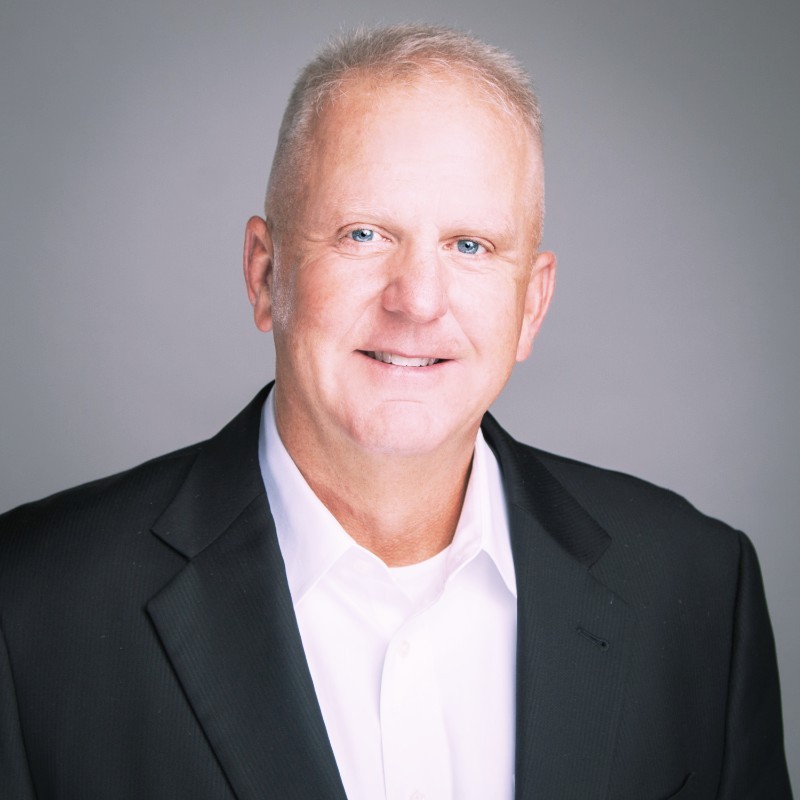
Darin Davis
Darin has over 18 years of real estate experience involving acquisition, development, management, and dispositions. In 2002, he founded his first with an initial emphasis on land entitlement, multi-tenant and Class B commercial retail centers. In 2009, Darin co-developed his first multifamily project in Austin, TX. Since then he and his business partners have focused their efforts on the multifamily sector primarily in the Texas marketplace. As a Sponsor and General Partner, he has directly participated in securing over $500,000,000 in debt and equity for acquisition and ground up construction. Darin is experienced in Public-Private Partnerships and HUD-insured loan products. He is an honored alumnus from the University of Oklahoma, and he and his family currently reside in the great state of Texas.
Episode Show Notes
Darin Davis is Principal and Co-Founder of Presario Ventures. He has over 18 years of real estate experience involving acquisition, development, management, and dispositions. In 2002, he founded his first with an initial emphasis on land entitlement, multi-tenant and Class B commercial retail centers. In 2009, Darin co-developed his first multifamily project in Austin, TX. Since then he and his business partners have focused their efforts on the multifamily sector primarily in the Texas marketplace. As a Sponsor and General Partner, he has directly participated in securing over $500,000,000 in debt and equity for acquisition and ground up construction. Darin is experienced in Public-Private Partnerships and HUD-insured loan products. He is an honored alumnus from the University of Oklahoma, and he and his family currently reside in the great state of Texas.
[00:01 – 04:54] Opening Segment
- Get to know Darin Davis
- Darin shares about his life and starting Presario Ventures
[04:55 – 10:29] Invest in Multifamily Development
- Why should you invest in multifamily development?
- “We were losing!”
- The Good Side of Investing in Multifamily Development
[10:30 – 31:18] Multifamily Development vs Acquisition
- Resources, Development, Market Downturn, and Costs
- Inflation is the big buzzword now!
- Darin talks about sensitivity underwriting
- When does debt become your friend?
- “That’s not us!”: A Unique Way of Finding Assets and Catering to their Specific Markets
- What is Build To Rent?
- BTR Costs versus Apartment Costs
- Here’s What You Should Do when Evaluating Your Deals
- “It’s based on them first.”
- Darin endorses Tom Burn’s book, Why Doctors Don’t Get Rich
- How Darin and Tom started their partnership with one another
- Levelling up Your IRR in Six Weeks
- Why Focus on Either Multiple or Cash on Cash
[31:19 – 41:25] Closing Segment
- Quick break for our sponsors
- Groundfloor offers short-term, high-yield real estate debt investments to the general public. Check www.passivewealthstrategy.com/groundfloor/ to get started.
- What is the best investment you’ve ever made other than your education?
- Their team
- Darin’s worst investment
- Not listening to the people closest to him
- What is the most important lesson that you’ve learned in business and investing?
- Building a relationship
- Connect with my guest. See the links below.
Tweetable Quotes:
“We have so much more control.” – Darin Davis
“We put a lot of space between the good and the probable.” – Darin Davis
“Be actionable.” – Darin Davis
“At some point, it’s okay to say ‘no’.” – Darin Davis
————
Connect with Darin Davis through [email protected] and LinkedIn. Visit their website https://presarioventures.com/. Grab a copy of Why Doctors Don’t Get Rich.
Invest passively in multiple commercial real estate assets such as apartments, self storage, medical facilities, hotels and more through https://www.passivewealthstrategy.com/crowdstreet/
Participate directly in real estate investment loans on a fractional basis. Go to www.passivewealthstrategy.com/groundfloor/ and get ready to invest on your own terms.
LEAVE A REVIEW + help someone who wants to explode their business growth by sharing this episode or click here to listen to our previous episodes


